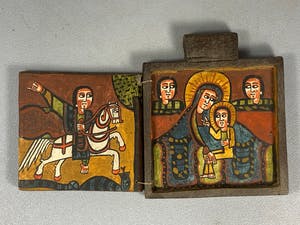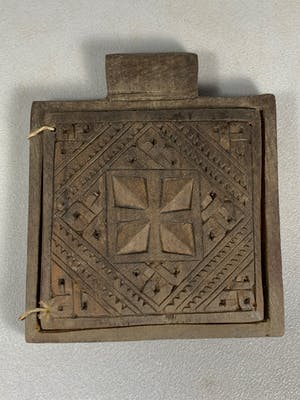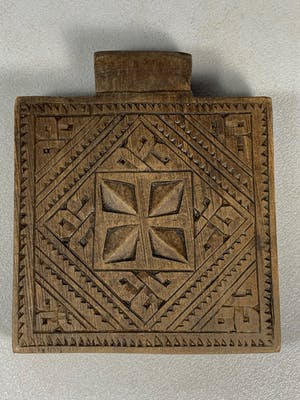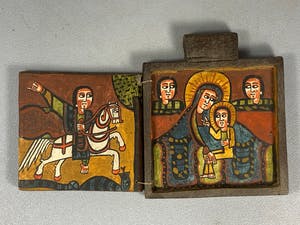Dogon - Ethiopisch wooden icon with 2 handpainted icons. - Ethiopia - Vendu

- Description
- Dogon
| Type d'œuvre d'art | Objets ethnographiques |
| Période | 1900 à 1944 |
| Technique | Bois |
| Style | Africain |
| Sujet | Autre |
| Dimensions | 14 x 22 x 3 cm (h x l x p) |
Ethiopisch wooden icon with 2 handpainted icons. - Ethiopia
when icon open it is 22 cm x 14 cm.
Taxatiewaarde: 100 - 175 euro
The richly hued biblical paintings of Ethiopian Icons primarily illustrate scenes from the old testament. Until the middle of the 20th century, the paintings of Christian Ethiopia remained virtually unknown outside its borders. Yet over the course of the past millennium, Ethiopian artists have produced a vast quantity of unique and creative icons, illuminated manuscripts and wall paintings in churches. By virtue of its geographical position, Ethiopian paintings belong to Africa, however, due to close contacts with the adjacent areas, their art incorporates elements of the Eastern and Western Christian artistic tradition, as well as those of Coptic and Islamic cultures and the cultures of the people of the Indian Ocean area. Ethiopian artists succeeded in embracing and transforming significant elements of these traditions, while their paintings remained a unique phenomenon deeply rooted in the African soil.
The purpose of Ethiopian art is to describe in color, the drama of the gospels. The icons have been used for devotional purposes, both as objects of power and as votive offerings. They are believed to be permeated with the spiritual presence of the saints and in particular of the Virgin Mary. Prayers made to an icon are offered directly to a specific saint or to the Virgin herself. The icon can elicit either a blessing on the righteous or punishment to wrongdoers. The faithful often commissioned icons with the intention of obtaining God's mercy, as well as the intercession and protection of the Virgin Mary.
These icons are made of wood and painted panels, of stone, or a combination of both. They are used on personal altars or worn as a personal talisman for protection on a cord around the neck or tucked into a pocket. They are usually a collaboration between two types of artisans: the carver who makes the wood or stone case and a painter who draws upon a repertoire of biblical themes.
| État | |||
| État | Très bon | ||
| Expédition | |||
| Retrait sur place | L'œuvre peut être récupérée sur place. En tant qu'acheteur, vous devez apporter vos propres matériaux d'emballage. L'emplacement est : Hengelo, Les Pays-Bas | ||
| Envoi | Colis postal | ||
| Prix | Jusqu'à 5 kg.
| ||
| Garantie | |||
| Garantie | En mettant le lot en vente, j'accepte les conditions de garantie telles qu'elles s'appliquent sur Kunstveiling en ce qui concerne l'exactitude de la description du lot mis aux enchères | ||
Le vendeur assume l'entière responsabilité de ce lot. Kunstveiling ne fait que fournir la plate-forme pour cette transaction, à finaliser directement avec le vendeur. Plus d'informations .


